No Products in the Cart

Created on: February, 2022. Last Updated on: February 3rd, 2025.
Most drones are designed to fly in temperatures varying from -20 degrees Celsius to 50 degrees Celsius. However, when the temperature of the lithium polymer battery drops below 10 degrees Celsius you will notice a drop in performance. Larger issues begin to occur when the battery reaches -7 degrees Celsius. It is possible to fly during the winter months, but you will need to pay close attention to these important factors.
This is one of the most important factors to understand while flying during the winter months. Have you ever noticed your iPhone or Android phone shut off due to cold temperatures? This occurs because batteries are not designed to work well in subzero temperatures. Fortunately for us there are a few things that we can do to minimize the effects of the cold weather.
To combat this:
In aviation, there are atmospheric conditions that can lead to the formation of ice on an aircraft. Icing begins to occur at 0 degrees Celsius and can accumulate on the aircraft and propellers, which can lead to prop damage. In more extreme cases where excessive icing has taken place a crash may occur.
Ensure that your aircraft and the propellers are completely dry before you assemble the drone for flight. If you suspect icing is occurring, land immediately and set your drone in a warm place before flying again.
Avoid precipitation at all costs and do not fly if it is snowing or blistery outside. While the DJI Matrice 350 RTK does have an IP55 rating, it is still recommended to be cautious. Harsh weather conditions will significantly impact the quality of your deliverables whether it is the Zenmuse P1, Zenmuse L2, or Zenmuse H30 series.
Pay attention to the moisture in the air before flying. If moisture comes into contact with your drone, it may damage the motor or electronics permanently. Even setting your drone on the snow during take-off or while landing is not advised.
You can avoid this by bringing a landing pad if you have access to one.

Exposure and white balance need to be monitored when shooting winter photos or videos. If your camera does not properly set the exposure meter automatically your images will appear to be overexposed. This creates a bright, grey image with little to no detail. We suggest manually setting your exposure and white balance settings to properly shoot or record photo and video.
Here are a few tips regarding aerial photography:
Dress appropriately for the weather that you will be flying in. You will be stationary for long periods of time, outside, in the elements. Make sure you wear a jacket, insulated boots, mittens or a transmitter glove, and a toque.
If you’re cold you will be uncomfortable, and it will be much harder for you to focus on your mission. Cold fingers or hands can lead to potential disaster while flying; you may want to consider using touch sensitive gloves if you use a touch screen enabled controller.
Give us a call or drop by anytime, we will answer all enquiries within 24 hours on business days. We will be happy to answer your questions.